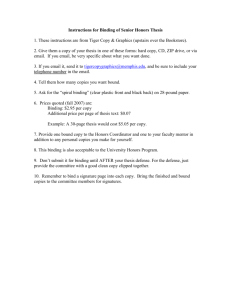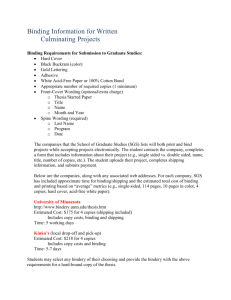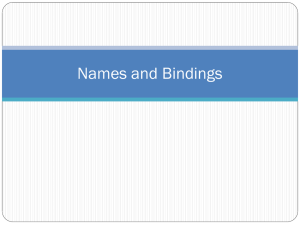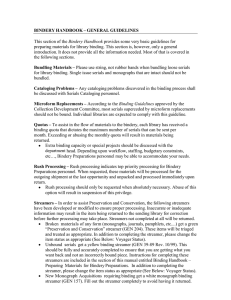BINDERY HANDBOOK – PREPARING MATERIALS FOR BINDERY PREP Rationale:
advertisement
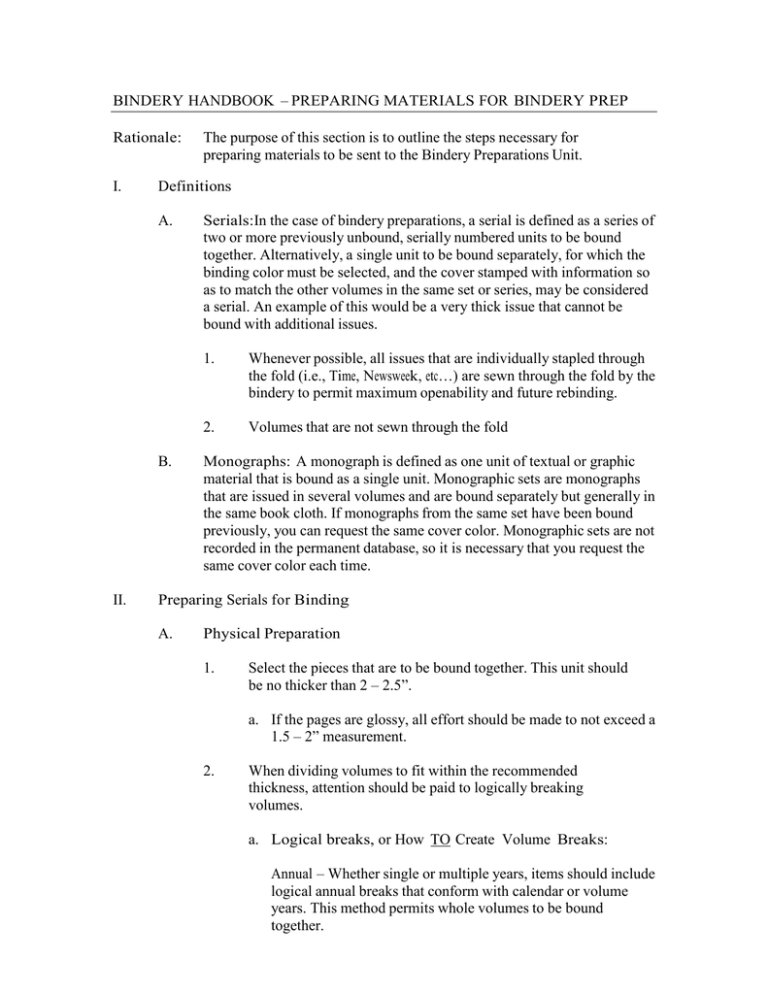
BINDERY HANDBOOK – PREPARING MATERIALS FOR BINDERY PREP Rationale: I. Definitions A. B. II. The purpose of this section is to outline the steps necessary for preparing materials to be sent to the Bindery Preparations Unit. Serials:In the case of bindery preparations, a serial is defined as a series of two or more previously unbound, serially numbered units to be bound together. Alternatively, a single unit to be bound separately, for which the binding color must be selected, and the cover stamped with information so as to match the other volumes in the same set or series, may be considered a serial. An example of this would be a very thick issue that cannot be bound with additional issues. 1. Whenever possible, all issues that are individually stapled through the fold (i.e., Time, Newsweek, etc…) are sewn through the fold by the bindery to permit maximum openability and future rebinding. 2. Volumes that are not sewn through the fold Monographs: A monograph is defined as one unit of textual or graphic material that is bound as a single unit. Monographic sets are monographs that are issued in several volumes and are bound separately but generally in the same book cloth. If monographs from the same set have been bound previously, you can request the same cover color. Monographic sets are not recorded in the permanent database, so it is necessary that you request the same cover color each time. Preparing Serials for Binding A. Physical Preparation 1. Select the pieces that are to be bound together. This unit should be no thicker than 2 – 2.5”. a. If the pages are glossy, all effort should be made to not exceed a 1.5 – 2” measurement. 2. When dividing volumes to fit within the recommended thickness, attention should be paid to logically breaking volumes. a. Logical breaks, or How TO Create Volume Breaks: Annual – Whether single or multiple years, items should include logical annual breaks that conform with calendar or volume years. This method permits whole volumes to be bound together. Bi-annual – Volumes are split into two pieces, i.e., January – June and July – December. Tri-annual – January – April, May – August, September – December. Quarterly – Volumes are split into three pieces, i.e., January – March, April – June, July – September, and October – December. Bi-monthly – Materials are bound once every two months. Six bound pieces equal one calendar year. Monthly b. Illogical breaks, or How NOT TO Create Volume Breaks: January – Mid-March – The first binding unit for a calendar year spans from January to mid-March. The second runs from mid- March to mid-June. December 2000 – Mid-January 2002 – Not only are months split unnecessarily, but the calendar year is split illogically. The result for variable spine information is that there are two sets of volume and issue numbers. Split Volumes – Binding six months of 1997 and 1998 together if it means that there are parts of serial volumes bound into each piece is confusing to users and poor bibliographic practice. 3. Check if any issues are missing from the batch. a. If the answer is yes, see if the piece was checked out or not received. If the missing issue is checked out, wait for it to return before binding or attempt to recall the piece. If the piece was not received, attempt to claim or replace the missing issue before binding. b. If the answer is no, go to the next step. 4. Remove all inserts and loose advertisements. Note if there are folded pages, errata sheets, or loose indices or tables of contents. 5. Stack the issues as they will be bound, i.e., with the earliest in the series on the top of the pile. For a monthly piece, the volumes should progress from January to December. For numbered pieces, the volumes should progress from volume 1:1 to 1:2, to 1:3, etc…. Bindery Preparations does not untie and check the order of every piece received. Consequently, serials are bound in the order they are received. It is the responsibility of the preparing library to ensure that their materials are bound in the correct order. Please check the order carefully before sending them. B. 6. Ensure that the issues are labeled with the correct call numbers, volume/year, and copy number. Each issue must have a label. 7. Rubber-band the issues together. 8. If the pieces to be bound are older, please check to see if they are brittle. To do this, complete a fold test by folding the corner of a single page over itself and back again three times. If the corner breaks off, the paper is too brittle to be commercially bound. Consult with Preservation and Conservation staff about what to do with the pieces. Notes on Preparing Serials Binding Streamers 1. Use a previously bound volume as a guide for the marking when completing the yellow serials binding streamer (Gen form 39-89 Rev. 10/99). 2. Fully and accurately complete all piece specific information (call number, copy number, volume(s), month(s), year(s), etc…) on the binding streamer (see C. Preparing the Yellow Serials…). 3. Indicate whether or not the title should be sent to the Stacks upon return. 4. Make sure that the title is the same as the previously bound volumes. If the title or call numbers on issues are different, further investigation may be necessary before binding. 5. If a journal has not been bound by your library previously, check to see if another UIUC library “owns” a copy of the journal. If they have bound it previously, your library is required to use their marking pattern, color choice, title, etc…. Check with the owning library to confirm the color, marking information, etc…. If your library is the first to bind the title, you can choose the color, etc…. However, all title information should be consistent with the title visible on the OPAC. Check the marking note in the holdings record to see that it corresponds to the marking pattern you have chosen. 6. If you are binding a title which has been cancelled, ceased, or continued by another title, notify the appropriate individuals in Cataloging to ensure that records can be properly updated in the automated system. 7. If you are binding a title that has not been bound in the last three years or is in a non-Western language, include the title information in the section near the bottom of the streamer labeled “Title” as it appears in the OPAC. a. C. For non-Western characters, please include a neatly printed transliteration. As the Bindery Preparations staff do not have facility in all of the languages currently represented by the collection, the accuracy of your binding depends upon our being able to read this information. Preparing the Yellow Serials Binding Streamer 1. Sending Library:This is the three-letter code for your library. 2. Send to Stacks:Circle the appropriate response to whether or not this piece should be sent to the Stacks after binding. 3. Bound Before: Indicate whether or not the title has ever been bound before. If it's been over 10 years since the title was bound, please include the cover color of the previous issues. a. If the title is an analytic cataloged as a set, include the Library’s color preference for new titles as indicated in the Library Buckram Color Guide (available from the Bindery Preparations Unit). If no color preference is made for analytics, the default color choice is black. 4. Call Number: Include the full and proper call number for the piece with the appropriate cutter lines, etc…. This will be exactly what will appear on the spine of the bound volume, and it should match the call number that appears in the OPAC. a. If there are supplements, indices, or missing issues, please include this information in the Added Info Field (#17 below). This will permit our staff to add notes when space permits that will fit on the spine of the volume. b. The only variable information permitted in the call number is the copy number. No volume, issue, or date number should be included in this space. 5. Copy Number: If appropriate, include the copy number as it should appear on the spine of your bound volume. 6. Volume: If appropriate, write the volume number as it should appear on the spine of your bound volume. 7. Months: If appropriate, write the month or month(s) that should appear on the spine of your bound volume. Check to ensure that all months indicated are actually included. 8. Year(s):If appropriate, write the year(s) that should appear on the spine of your bound volume. Check to ensure that all years indicated are actually included. 9. Number(s):If appropriate, write the number(s) that should appear on the spine of your bound volume. Check to ensure that all numbers indicated are actually included. If there are missing issues or numbers, leave the missing number out. For example, a year of a monthly publication that is missing the November issue should be represented as the following: 1 – 10, 12. 10. Pages: If appropriate, write the pages(s) that should appear on the spine of your bound volume. Check to ensure that all pages indicated are actually included. 11. Abstract Number: If appropriate, write the abstract number(s) that should appear on the spine of your bound volume. Check to ensure that all abstract numbers included are actually included. If there are missing numbers, leave the missing number out. 12. Missing Issue Number: If appropriate, write the numbers of any missing issues so that records can be properly updated. Include a note in the Added Information field (#17 below) asking that “INC.” be part of the call number. This will indicate to the user that the bound volume is incomplete. 13. Page or Cover Folds: Indicate whether or not there are any page or cover folds in the set of issues to be bound. 14. Maps, Pockets, etc…: Indicate whether or not there are any maps, pockets, or other oddities in the set of issues to be bound. 15. If Not Bound…Title:If you are binding a title that has not been bound in the last three years or is in a non-Western language, include the title information in the section near the bottom of the streamer labeled “Title” as it appears in the OPAC. For nonWestern characters, please include a neatly printed transliteration. The accuracy of your binding depends upon our being able to read this information. 16. Added Information: Include any additional information about the piece that you believe the Bindery Preparation Unit should know about. Examples include: a. Narrow inner margins (less than 5/8th inch) should be noted as they affect the binding options. b. Library’s color preference for new titles as indicated in the Library Buckram Color Guide (available from the Bindery Preparations Unit). If no color preference is made for new periodicals, color choice will be at the Bindery Preparations Unit’s discretion. Also, include your color choice for new binding. c. Supplements, Indices, and Incomplete Volumes: If your piece has any of these, please include a note in the Added Information field indicating that a note should be made on the spine of the piece. • • • 17. III. For Supplements, use the abbreviation “Sup.” For Indices, use the abbreviation, “Ind.” For incomplete volumes, use the abbreviation “Inc.” Person to Contact: Include your name in this field. If there are problems or omissions on the streamer, this allows the Bindery Preparations staff to contact you for clarification or to return the item for more specific directions. Preparing Paperback Monographs for Binding A. Physical Preparation 1. Presently, the only monographs that should be sent directly to Bindery Preparations are: a. New paperback monographs requiring binding due to projected heavy use (e.g., materials for Reserve or Reference collections). b. New paperback monographs requiring commercial binding due to their physical construction (oversized, undersized, etc…) or due to poor construction. These are identified during initial processing Acquisitions processing. c. Undamaged paperback monographs that have circulated more than three times. 2. Records for new monographs selected for binding require that the Voyager item status is updated to indicate that the item is “At Bindery.” Those direct from Acquisitions processing should also have their item location indicate that the item is ”In Process.” 3. B. All monographs sent for binding that have moved beyond the Acquisitions processing phase should be sent with a completed Monograph Binding Streamer (Gen 157). One streamer must be completed for each volume. Determining Binding Style for Paperbacks – Digicover or “Buckram” Binding? 1. The following decision tree governs the decision-making process in the Bindery Preparations Unit for determining how paperback volumes will be bound. The decision tree is used for both new acquisitions selected for binding upon receipt based upon physical size or other criteria presented in the Library’s Binding Guidelines and for items that are already part of the collection and have (1) been damaged, or (2) circulated a minimum of three times. Binding Style Digicover Decision-Making Criteria New Un-circulated Books • Paperbacks • Weighing less than two pounds • Without “book jacket” style covers • Without accompanying materials (maps, CDs, etc…) • Is not bound with spirals, staples, combs, posts, or other incompatible binding structures as single Hard Bind/Save Any volume notsuch meeting abovesignatures • Suitable to be bound; cover intact criteria, and Covers in C-cloth • Weighing under two pounds • With or without accompanying materials (maps, CDs, etc…) • Containing any element making it unsuitable for digicover binding Suitable be bound Hard Bind/Save Any•volume nottomeeting above criteria, with paperback cover Covers in • Suitable to be bound Buckram • Weighing over two pounds With or accompanying Hard Any•volume thatwithout Binding Preparations materials Unit Bind/Economy determines: • Has hard cover that is damaged Book in • Has broken signatures on cover page Buckram • Can be adhesive bound May have accompanying material (maps, Hard Any•volume that Binding Preparations Unit CDs, etc.) Bind/Recase determines: • Has hard cover that is damaged Book in • volume Has intact for recasingUnit Do Not Bind/ Any that signatures Binding Preparations Buckram determines: Return to • Does not meet any above criteria Library • Has insufficient margins to bind safely VI. VII. Theses and Dissertations A. Theses and dissertations are received from the graduate schools shortly after the completion of each semester. B. All thesis and dissertations from the University of Illinois are bound in color 588 (royal blue). C. Unless specifically requested, theses and dissertations are considered lowpriority and are processed as time permits. Additional Notes A. Flush Binding 1. The current binding contract specifies that materials over three inches in thickness or materials that are exceedingly heavy will be bound flush bottom automatically, meaning that there will be no square on the bottom of the volume. This practice prevents gravity from exerting force on such bindings and pulling the text out of the case.

